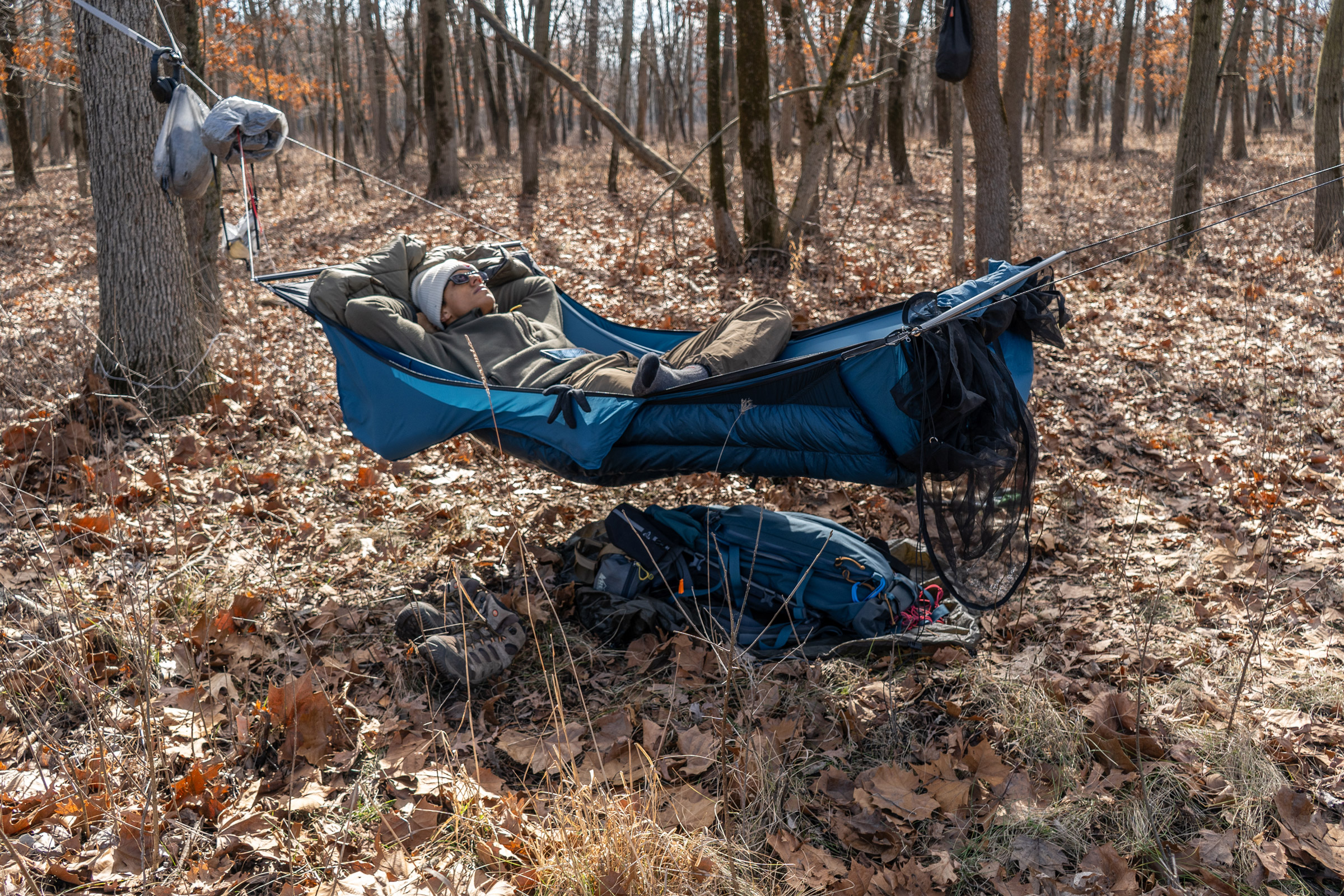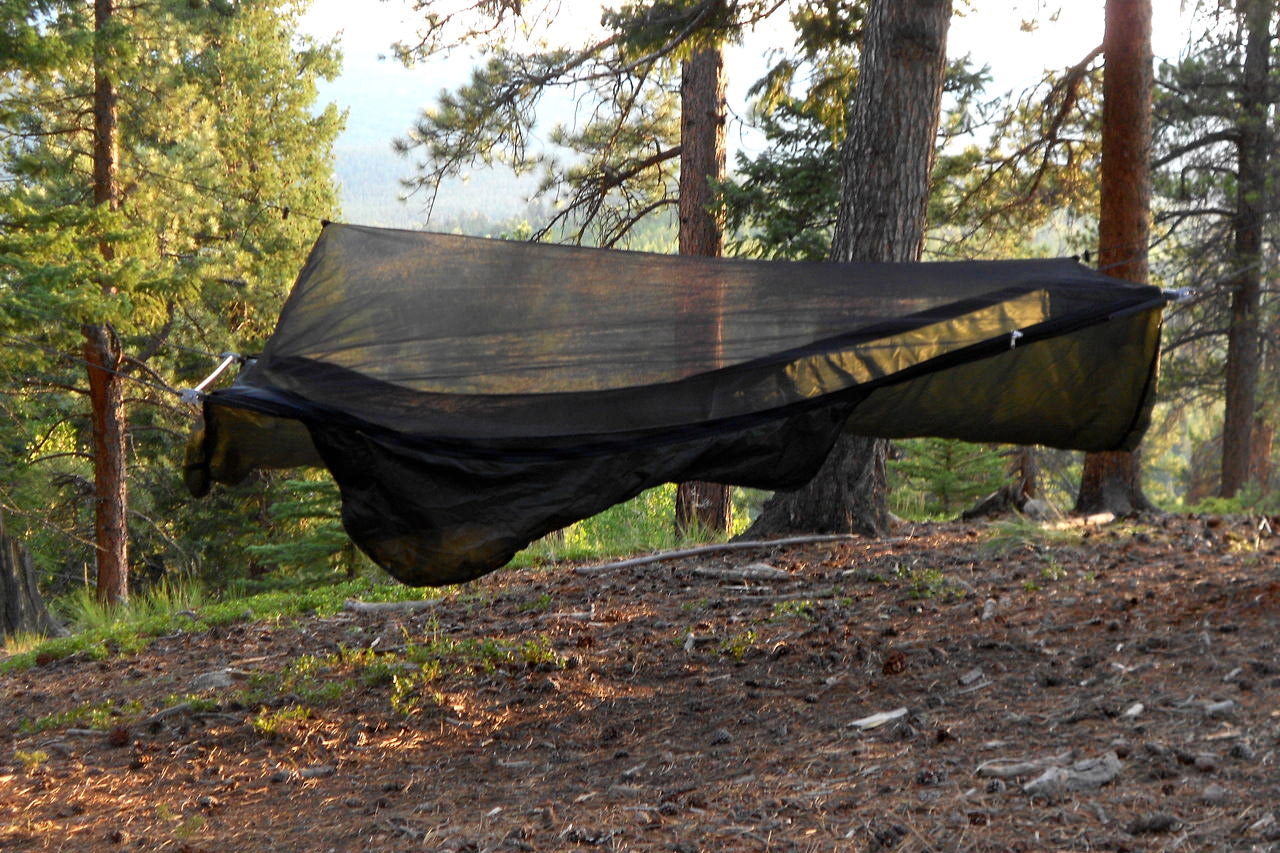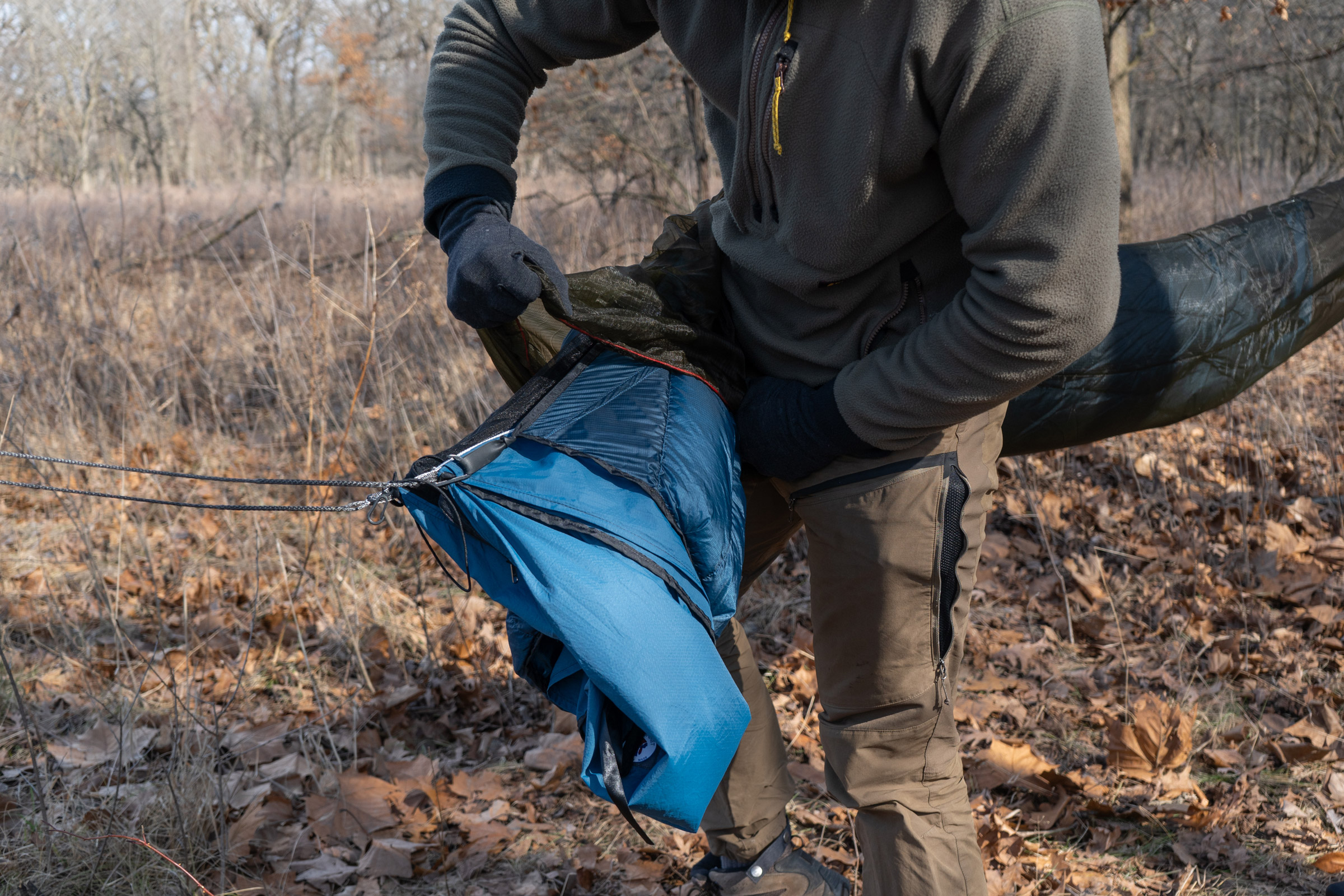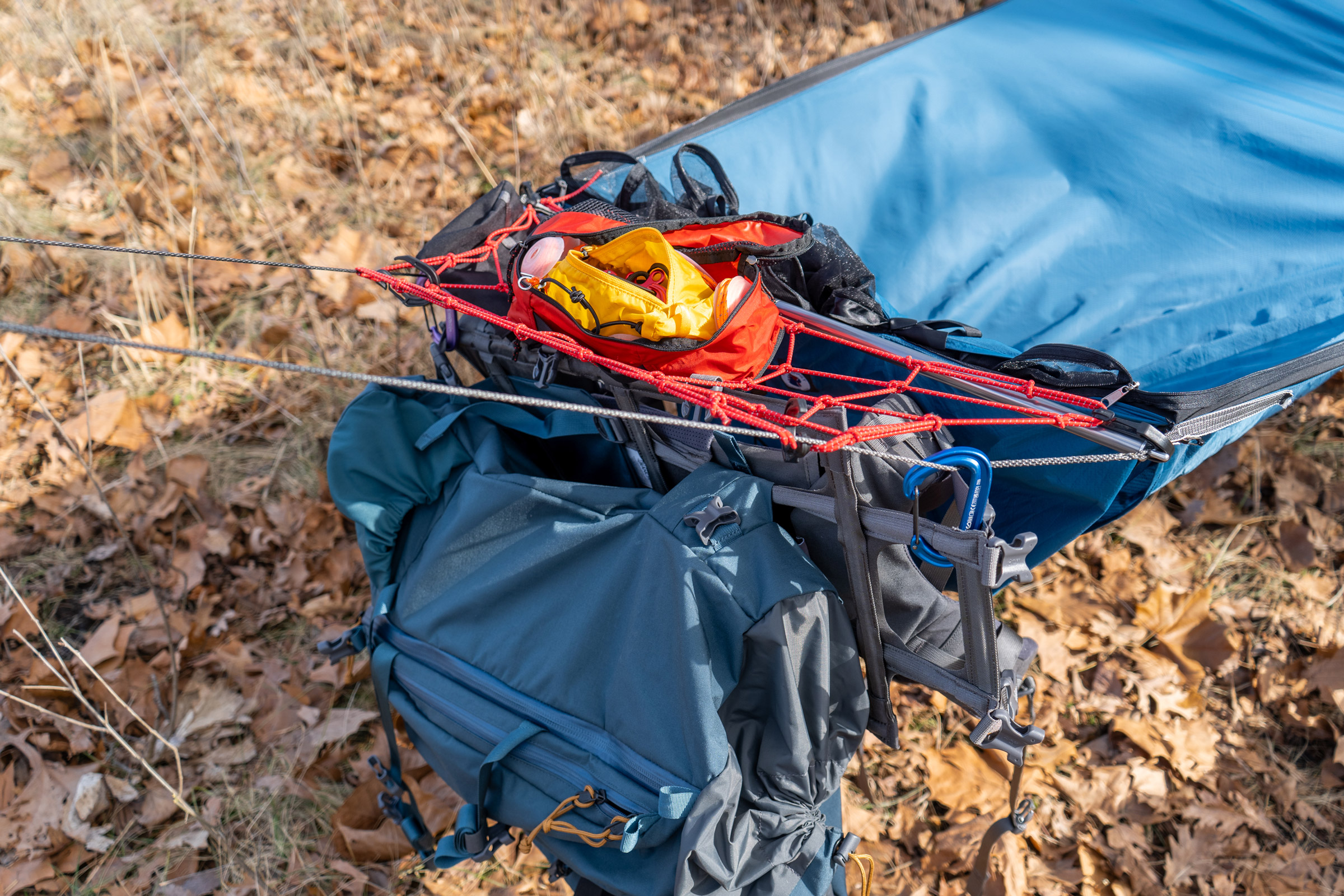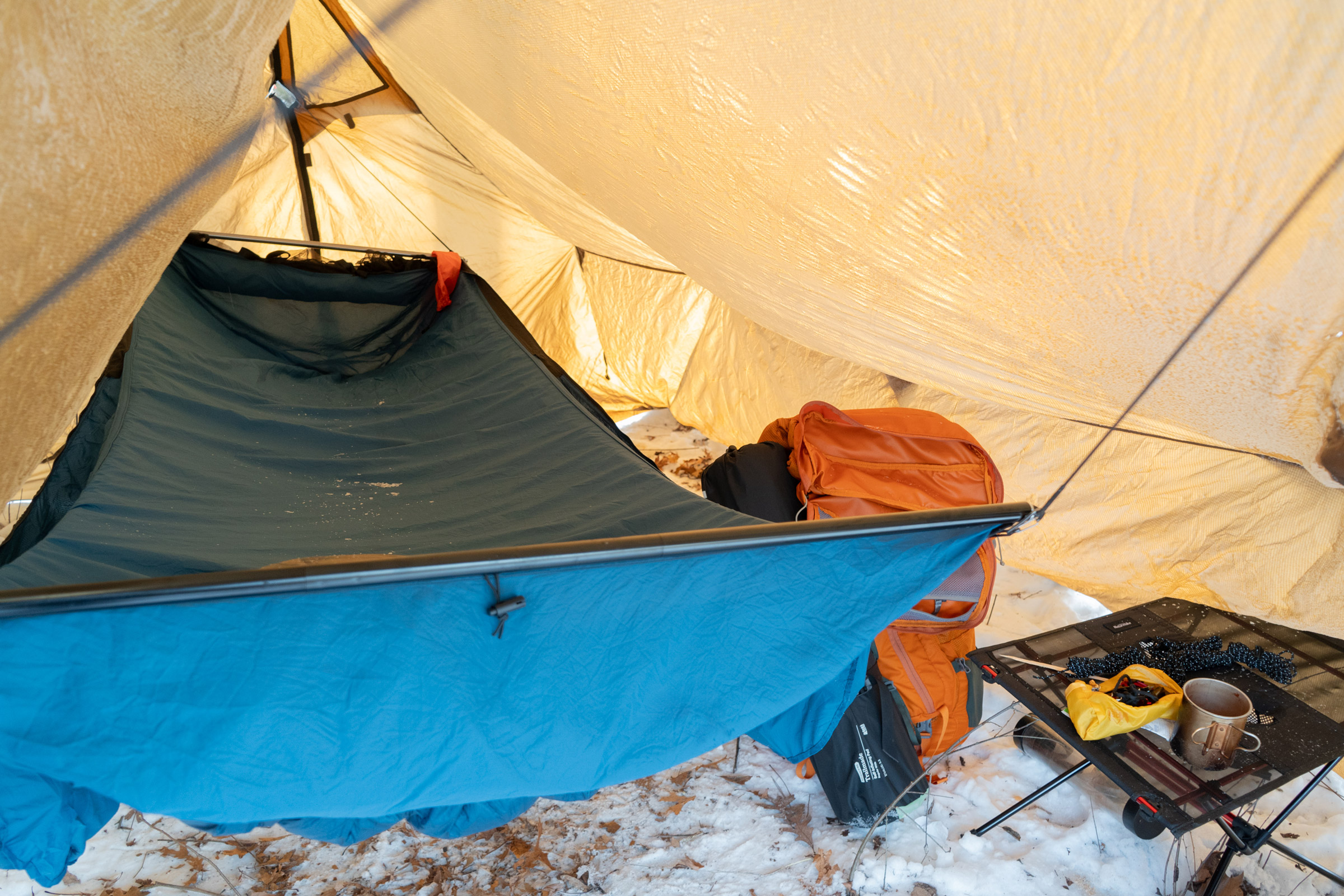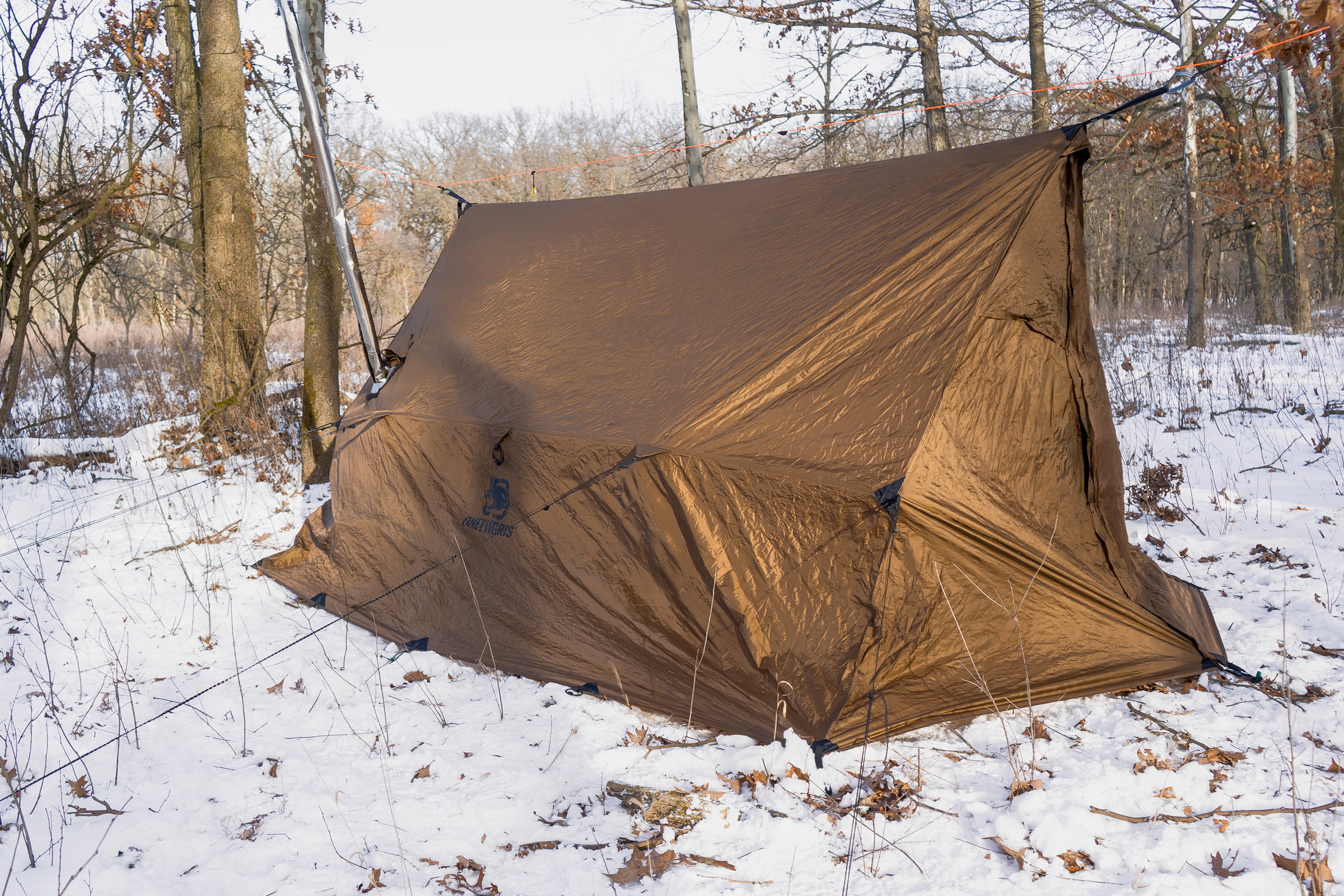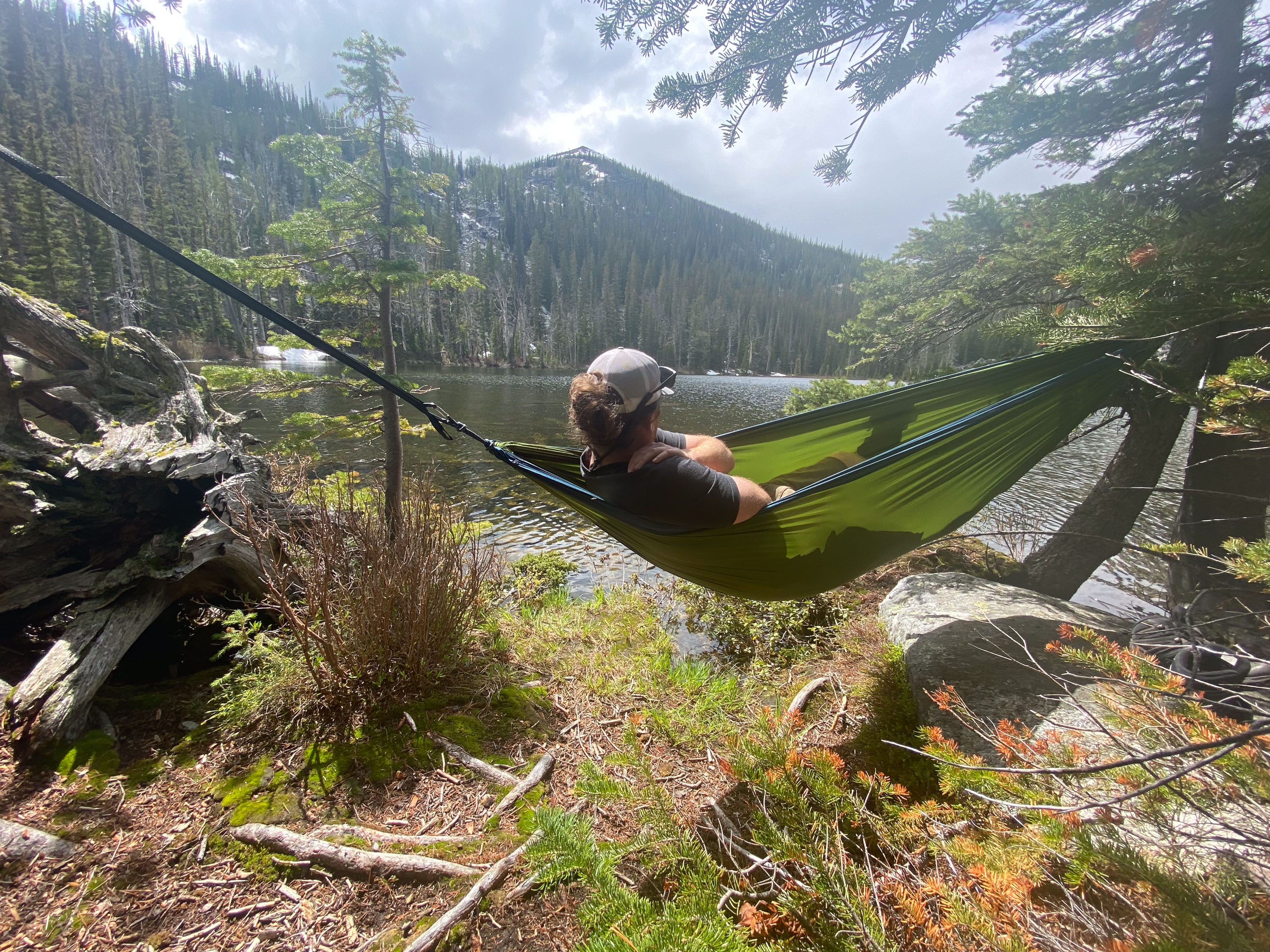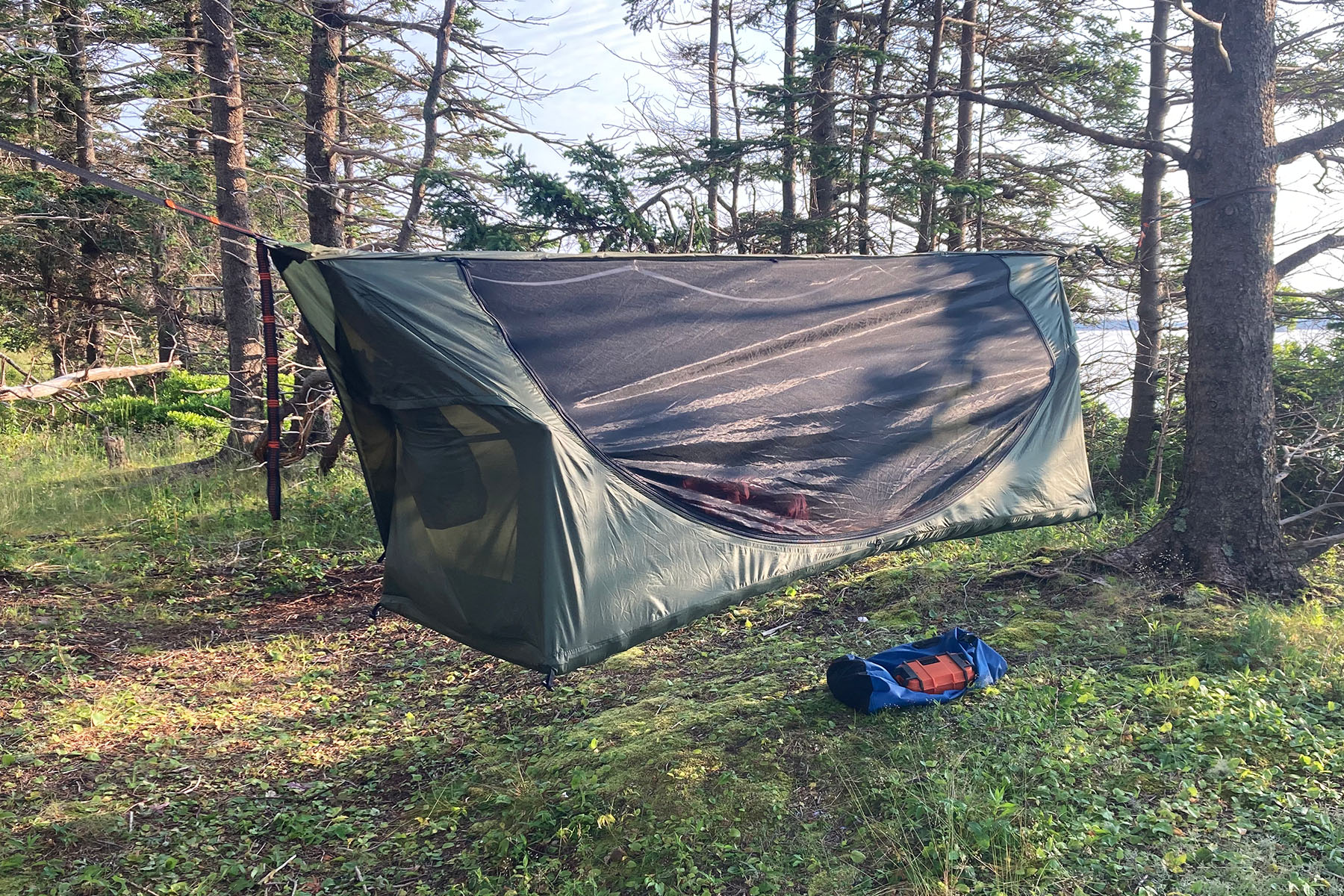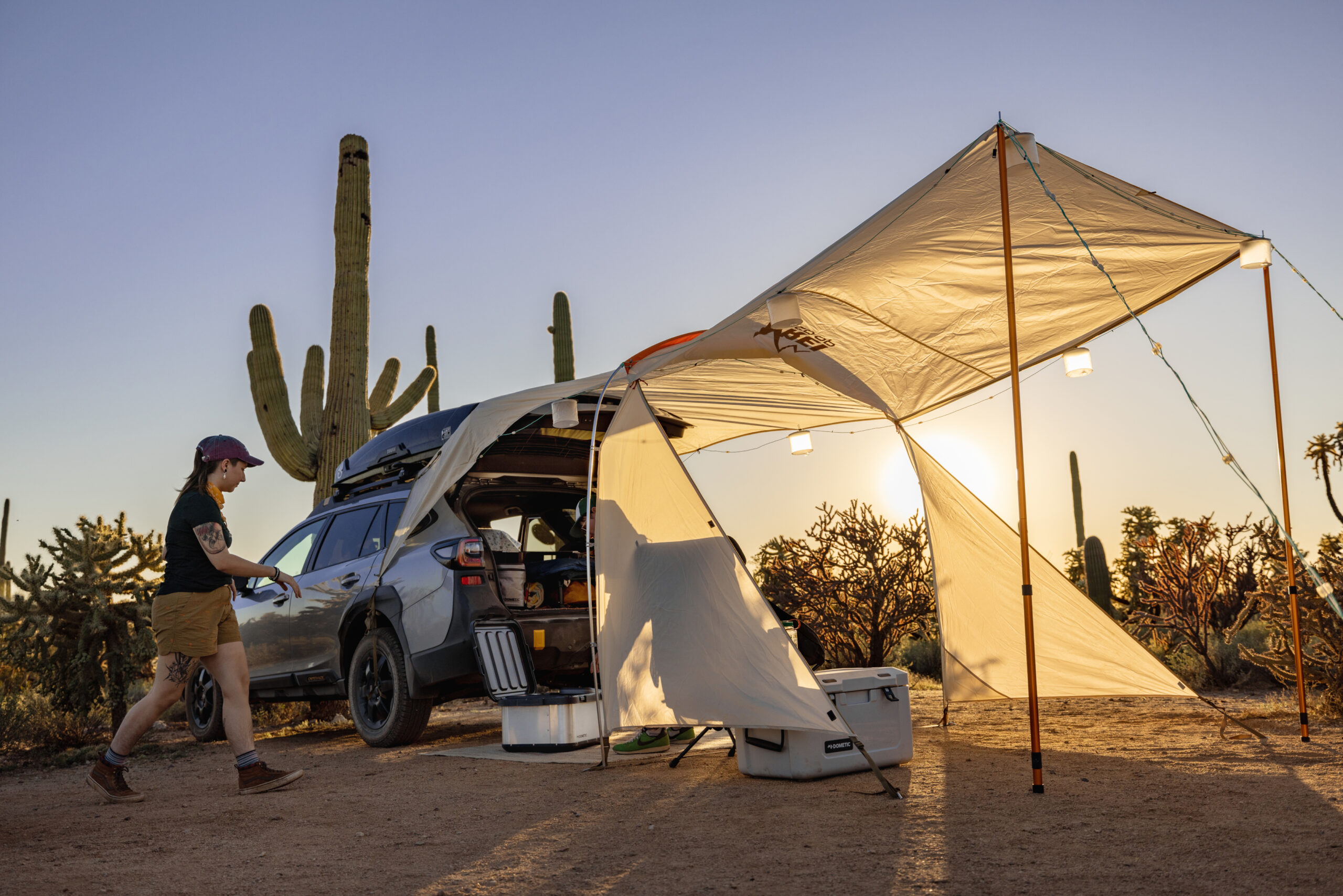My back isn’t “built different,” it’s built all wonky. The Warbonnet Ridgerunner and I have that in common. Hence, why I’m a hammock guy: It took time to learn how to achieve the perfect hang, but even so, I’ve yet to find a sleeping pad that does as well as a properly hung hammock at allowing my back and me to feel like we are, in fact, still under 30.
However, even with a preference for comfort and no issues with carrying extra weight, I still considered bridge hammocks — those with spreader bars for a flatter lay — the purview of backyards, car camps, and beaches. I believed the old refrain: They’re a touch more comfortable, but not worthy enough on the trail.
Until that is, I slept in Warbonnet’s updated Ridgerunner Hammock. After testing it alongside several hammocks recently, I can comfortably proclaim: The old refrain is dead; long live the bridge. Whether long trail or short, I’m Running with the Ridge. Yes, bars bring bonus ounces, but royal sleep is worth it.
In short: With moderate weight, integrated storage, a less synthetic-feeling fabric than most of its peers, double-layer options that allow for more flexibility in insulation strategy, and the most comfortable lay I’ve had between two trees — Warbonnet’s Ridgerunner compromises on little. It’s largest handicap? A low-capacity cap that probably isn’t what you think.
To compare the Warbonnet Ridgerunner to other camping hammocks on the market, check out GearJunkie’s Best Camping Hammocks Buyer’s Guide.
- Total Weight: 2 lbs., 4.6 oz.
- Max Capacity: 200 lb. comfort cap for single-layered, 250 lbs. for double
- Dimensions: 10.1' long, 3' wide
- Materials: Single or double-layered 30 or 40D Dream-Tex fabric
- Best For: Hammock camping, extended canoe trips, or anyone who values comfort over all else
Pros
- Incredible spacious storage
- Best-in-class comfort
- Moderate weight
- Flexible customization options
Cons
- May not be comfortable for heavier/broad shouldered individuals
- Fewer underquilt options
- Netting can be tricky to set up without a ridgeline
Warbonnet Ridgerunner Hammock Review
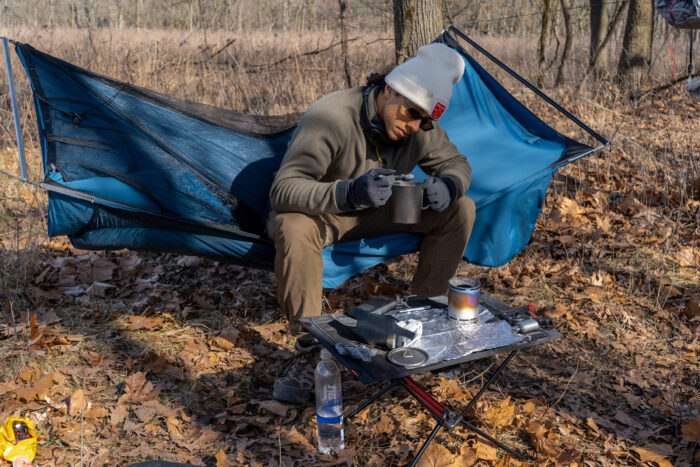
The Battle O’er Bridges
We’re in a weird meta time for hiking and backpacking. On one hand, anything ultralight is as trendy as ever. Some of the most heavy-duty pack manufacturers are even delving into UL territory. Running vest-style suspensions are slowly taking over the backpacking landscape.
On the other hand, in 2024, for many, it can be pretty hard to justify the high cost of low-weight gear. It’s increasingly common to hear reviewers shruggingly admit that a lot of ultralight gear isn’t that comfortable, and advise worrying less about your base weight.
Yet, when it comes to hammocks, the feeling is still so often, “You can go backpacking with a gathered-end hammock, but bridge hammocks aren’t worth the trail weight.” There are more than a few problems with that thinking.
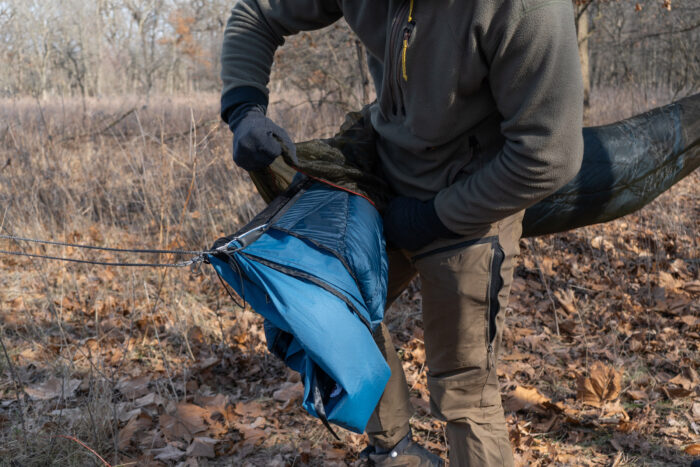
Extra weight is extra weight, and there is no denying that the 12 ounces of the Ridgerunner’s spreader bars is a noticeable bit of heft. But it’s not extra.
To achieve a flat lay, gather-end hammocks require long, wide cuts of fabric. Even hammocks like Hennessy’s, which famously use an asymmetric build for a flatter lay with less fabric, still routinely use cuts of fabric that are around 10 feet long and 5 feet wide. Meanwhile, even under tension, the Ridgerunner’s fabric comes in at under 7 feet long, and well under 3 feet wide at its widest section.
In a single-layered configuration, the fabric savings alone aren’t enough to offset the bars’ weight. However, pit the double-layered version of the Ridgerunner against other four-season, double-layered hammocks, and it quickly finds itself in the same weight class. The dimensions of the underquilt, too, save between an ounce and three on fabric and filling.
Put in perspective: Combining a double-layered Ridgerunner with a full 20-degree underquilt and the heaviest version of Warbonnet’s heaviest Cloudfly tarp would leave me with a shelter I’d feel plenty confident using in most places for all four seasons — for under 4.5 lbs.
In a week, I’ll be hitting the trail with a NEMO Dragonfly and a Tensor pad — a combo no one would call heavy. Much love to NEMO. They’ll save me a whole 0.7 pounds. But I’m sure I’ll miss the deeper sleep and heavier wallet that I had on the ridge between two trees.
Suspension Selections

The Ridgerunner, like all Warbonnet hammocks, offers three suspension options. The ones I tested, on the easiest and heaviest end of the spectrum, were the combo of buckles and 12-foot webbing straps.
Warbonnet’s buckle-and-cinch system is among the best. At all of 8.45 ounces, it’s lightweight. The webbing and buckles rarely get twisted. Even if you overtighten the straps (which can be easier to do with a bridge hammock), the buckles have a loop you can pull to easily disengage them. (And yes, gram-counters, you can drop the included carabiners to save 1.75 ounces and add 30-60 seconds to your setup time.)
For those who want a longer, lighter (per foot), and bushcraftier setup, Warbonnet also offers straps that can hang the hammock with a Becket hitch, sans hardware.
At the ultralight end of the spectrum are Warbonnet’s 6-foot UHMWPE whoopie slings — weighing in, even with a fish hook for attaching them, at under 2.5 ounces. While I didn’t use Warbonnet’s specifically, I did use the Ridgerunner with one of the half-dozen whoopies I had around. Almost universally, they offer the least span, midde-of-the-pack adjustment ease, the lowest weight, and a built-in drip line for diverting rain.
Simple Setup
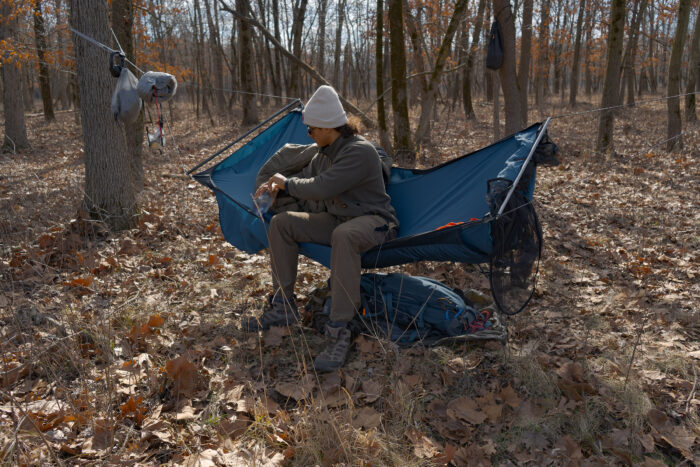
The Ridgerunner was a reminder of how easy setup can be. There is no ridgeline to work around. Instead, there’s a threshold. Tighten the straps enough, and the spreader bars provide all the tension you need for a flat lay. In practice, this meant that while I typically hang straps for gather-end hammocks at around 30 degrees, with the Ridgerunner, my straps had around a 20-degree hang.
This made a few differences. With gathered-end hammocks, there is always some fine-tuning: Hang it. Sit in it. Things stretch. Adjust the suspension height and tension. Sit in it again. Adjust it again.
Being a bridge, the Ridgerunner stretches and sags less with weight in it. I could position it lower when I needed to stack hammocks. When I needed to span far trees, I didn’t have to set my suspension at a height that made me wonder if this would be possible for the vertically challenged.
I found that the savings in fine-tuning time outweighed the 20-30 seconds it took me to set up the spreader bars. Warbonnet also offers a kit to convert some trekking poles into spreader bars — all but negating the weight tax of a bridge hammock, at the expense of a few extra minutes of setup. (Although, it’s worth noting that this is an item less often in stock.)
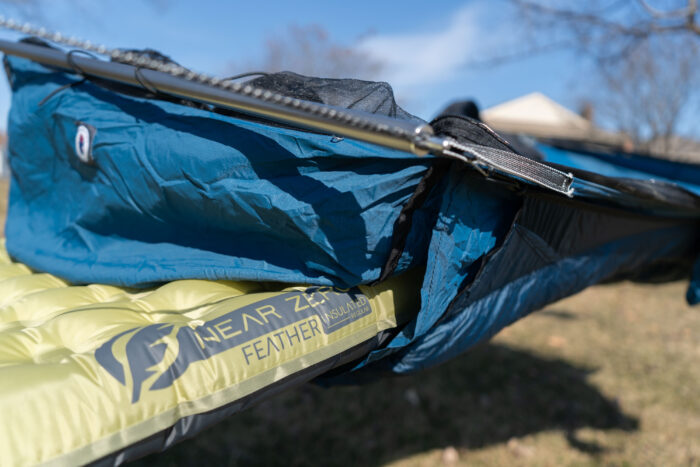
Notably, older versions of the Ridgerunner had hardware for the spreader bars to slot into. Now they slot into a loop on the suspension. And once, at the end of a weary day, I easily slotted the bars into the loop just below, on the hammock itself, instead of the suspension, by accident. Something that, done a few more times, could damage the stitching.
For those coming from gathered-end hammocks, there are a few other peculiarities: More tension and less sag mean that it’s much more noticeable if you hang the head end lower than the foot. Likewise, the perfect chair height is a bit lower to the ground.
The temptation to tighten the suspension more can make adjustments more difficult with a whoopie sling. Also, on a windy day, leaving the spreader bars in and the hammock unoccupied, is a recipe for coming back to a hammock more twisted than my sense of humor.
Even so, I routinely found the Ridgerunner to be among the fastest to dial in hammocks I’ve used. This was all the more true once I factored in the underquilt. Smaller than a gathered-end quilt, it was quicker to stow.
For setup, I only needed to clip into each corner of the hammock. No need to adjust a bunch of straps or fiddle with its sag to get it perfect.
Premium Relaxation — Conservative Cap
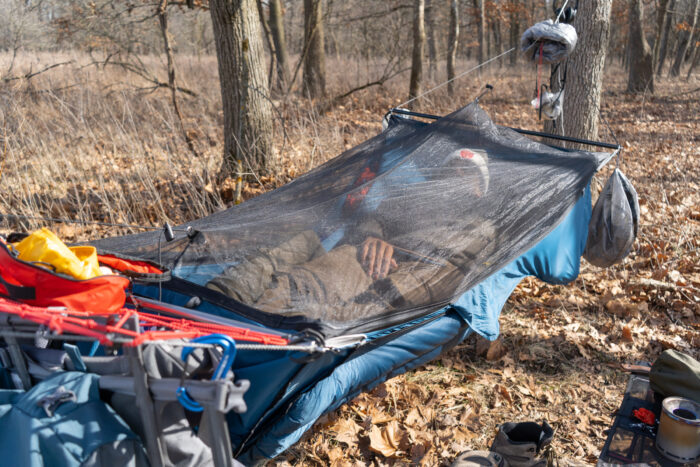
I have over half a dozen hammocks I will be selling several to get another Ridgerunner. It’s that damn comfortable.
My only bad night’s sleep was a weary evening where I did everything wrong: I hung the head end too low, didn’t tension the suspension enough, and put the poles into the wrong hole. The morning saw my back and me at it again, feeling older than my age.
Every other given night, however, the Ridgerunner was not only the most comfortable hammock I’ve ever slept on, but it was also the first where I could sleep the entire night on my side. Of course, amid all the comfort, there were two elephants in the room.
Bridge hammocks feel more prone to tipping than gathered-end hammocks. The same is true for Ridgerunner. Even so, with the suspension taut and no gear in its saddlebags to counterbalance me, I could still lean out of the hammock and safely pick stuff up on the ground. Even grooving along to my tunes, I was miles from tipping.
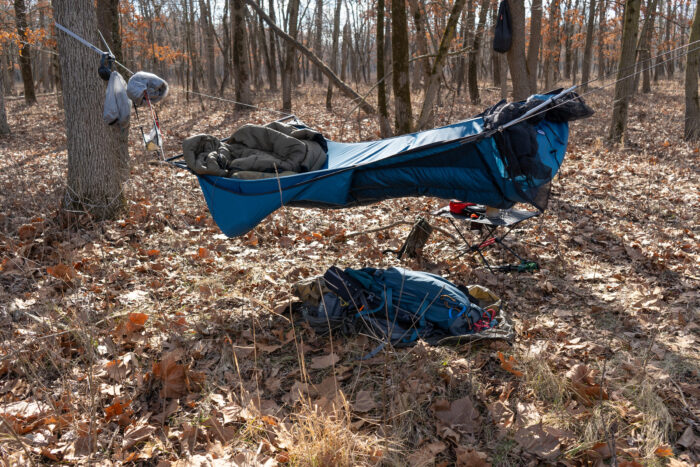
Max Occupancy Limit
The other comfort cap is more notable. Warbonnet’s recommended maximum occupancy weight for the double-layered version I tested is 250 pounds. However, this is a comfort cap, not a safety limit. Speaking as someone who grabbed some extra weight just to test the Ridgerunner out with 275 pounds in it, no part of this construction is failing around that weight.
The limiting factor here is the shoulders. Given the tension spreading the hammock apart, there is reinforcement along the sides of the hammock. Those wide and heavy enough will have the fabric wrapping around their shoulders with the tension of a touch-too-narrow jacket.
I’m only 200 pounds. Still, with shoulders around 19 inches wide and a 44-inch chest, I have just enough muscle piled awkwardly onto an otherwise skinny frame to approximate a relatively broad torso. While the Ridgerunner was never uncomfortable, if my shoulders were an inch or two wider, I were a bit heavier, and I slept flat on my back, it might not be my go-to.
Fingers crossed that Warbonnet eventually decides to offer an XL version of the Ridgerunner. Until then, while weight is a decent indicator, I would say that if you’re tall, and anyone has ever compared your shoulders to barn doors, purchase with caution.
Storage Galore
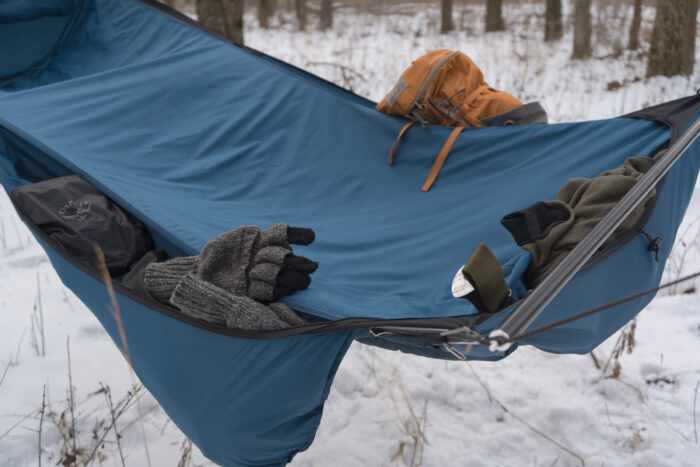
I’m more than a bit of a storage hound. I love compartmentalization. I spend hours optimizing my packing — to save all of a few seconds. So, the Ridgerunner was right up my alley.
Between two massive side saddlebags and a wide overhead pocket, I’d estimate that the Ridgerunmer offers 24-30 L of integrated storage capacity. For someone who normally obsessed over having all of my gear hung up and off the ground, simply being able to reach into a pocket and get whatever I needed without ever having to get out of my hammock in the middle of the night, was a godsend.
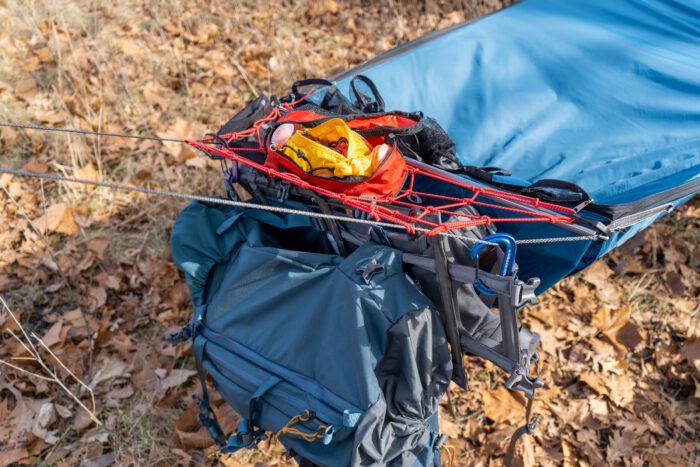
Then I started tinkering. I normally toss a small shock cord cargo net on the front of any pack with loops or daisy chains. I found that suspending that net or my pack’s rainfly across the spread ends of the split suspension gave me yet another pocket to hold gear.
As someone who often uses pods, dry bags, or cubes to compartmentalize gear, I loved being able to clip various bags onto the found corners of the hammock and keep every piece of gear compartmentalized, dry, and close by.
Said storage does come with some limitations. The various pockets are convenient. They’re not close enough to keep your water or filter from getting frozen in cold enough weather.
Likewise, with no ridgeline — unless you add ridgeline — there is no overhead storage. So, if you like to hang your headlamp overhead for a light, or watch a movie hands-free on your phone at camp, you’ll have to get a bit creative.
Warbonnet Weatherizing
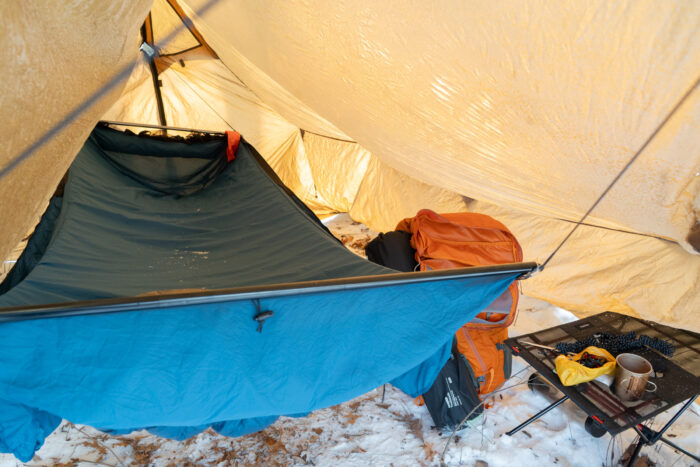
The double-layered Ridgerunner is a fine four-season platform, with some exceptions. With a little work, most underquilts can work with most gathered-end hammocks. Save for asymmetrical hammocks, there’s widespread compatibility.
With a bridge hammock like the Riderunner, that’s harder to do. For the most part, the options are its native Lynx underquilt or bust.
The Lynx is fantastic. Having to cover less fabric, the 20-degree version I tested easily compressed down to about 5-6 L. It boasts the simplest setup of any underquilt I’ve ever used. It comes in 40-, 20-, and 0-degree (Fahrenheit) options.
With the full-length version starting at $230 and the torso-length versions starting at $200, it’s also par for the course price-wise, for cottage gear. However, this does mean that there aren’t any good budget alternatives or non-down-under quilts for those with allergies.
Sleeping Pad Compatability and Bug Netting
Fortunately, the double-layered version of the Ridgerunner offers a slot to slide a sleeping pad into. Every double-layered hammock offers this, and with a bridge, it’s actually comfortable. Pairing a NEMO Switchback with a 20-degree Lynx, I was plenty warm in single digits — albeit a bit annoyed with how much the narrow pad shifted around. With a wider pad, like my 25-inch Near Zero Feather, I wouldn’t hesitate to hang well into the negatives, even with a 20-degree quilt.
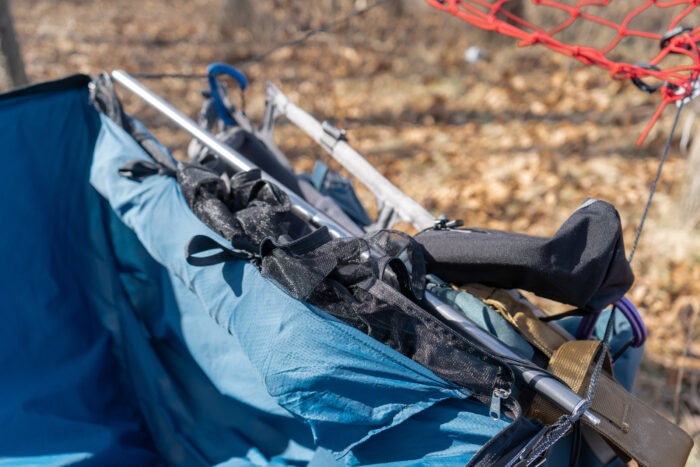
In bug season, you may find some annoyances. The Ridgerunner’s bug net is well-engineered, with internal grommets for a gear/sag-prevention line. On the outside of either end is an elastic that you can clip to where the split suspension lines converge.
This lofts the net off your face, but it’s still somewhat claustrophobic. Likewise, tensioning the shock cords enough to get the net high above, makes operating the zipper difficult. Fortunately, if you’re willing to throw a ridgeline into your setup, you’ll have plenty of space and an easier time getting in and out, by simply clipping the net onto the line.
Being shorter than most hammocks makes it easy to fit the Ridgerunner and all your gear under even the smallest tarp. The tradeoff: Pitch said tarp at a steep angle, and the spreader bars will probably hit the sides. Likewise, most tarps with doors less than 12 feet long won’t be able to cinch around the Ridgerunner’s split suspension lines without them rubbing against said tarp.
Warbonnet Ridgerunner Hammock: Conclusion
As someone who’s been a gathered-end guy for years, there were the little things I had to learn.
I left the Ridgerunner setup in the wind while I gathered firewood, returning to find a makeshift kite. Solution: Drop a bottle in either saddlebag or pull the poles.
I went on a hike with my camp fully set up and came back to my quilt covered in frost. With a gathered-end hammock (that hadn’t been staked out) the frost wouldn’t been confined to the outside of the hammock. Laying in the open of a bridge hammock, everything saw a light kiss of ice. Solution: pull the poles.
As warm as the underquilt was, it was only beneath me on a bridge hammock, not wrapped around my sides. Solution: tuck my top quilt a little tighter around my shoulder, or opt for a sleeping bag.
With my usual tarp, the doors would be spread by the split suspension. Solution: Pull them out further or set up broadside to the wind.
There were little tricks to learn. Yet, even with half a dozen other hammocks I have lying around, each one I have vastly more experience with, none of them have seen the light of day since I started using the Ridgerunner.
This hammock costs more than a Hennessy but is about the same as most other cottage hammocks. It integrates a vast amount of storage. And it sets up faster. By a country mile, it’s the best I’ve slept in the woods. Counting grams is dead. Long live sleeping like a king.
